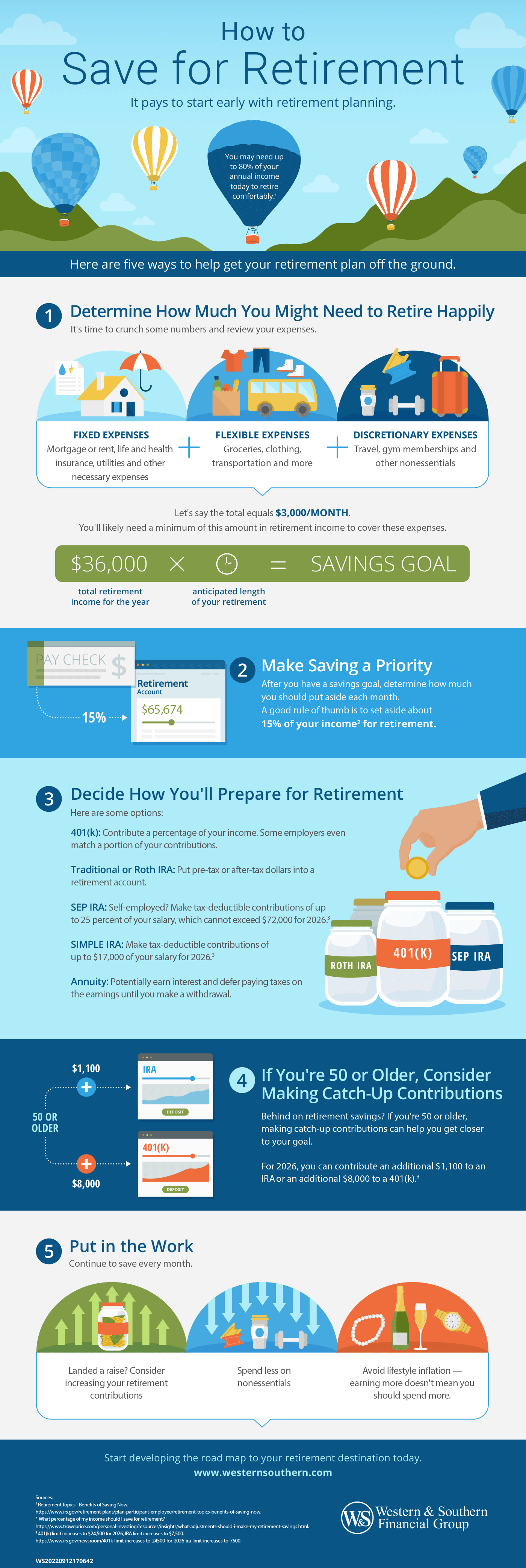

Table of Contents
Key Takeaways
- Calculate your fixed, flexible, and discretionary expenses to estimate how much income you'll need in retirement. This will help you set a savings goal.
- Allocate a portion of your income towards retirement savings. A general guideline is to save around 10-15% of your income for retirement.
- Consider options like a 401(k), traditional or Roth IRA, SEP IRA (for self-employed individuals), or SIMPLE IRA. Each option has its own advantages and contribution limits.
- If you're behind on retirement savings, take advantage of catch-up contributions. In 2023, individuals aged 50 or older can contribute additional amounts to IRAs and 401(k)s.
- Continually save each month, and consider increasing contributions when you receive a raise. Control nonessential spending and avoid lifestyle inflation, even as your income increases.
It pays early to start early with retirement planning.
You need up to 80% of your annual income today to retire comfortably1.
Here are five ways to help get your retirement plan off the ground.
Step 1: Determine How Much You Might Need to Retire Happily
It's time to crunch some numbers and review your expenses.
- Fixed expenses: Mortgage or rent, life and health insurance, utilities and other necessary expenses
- Flexible expenses: Groceries, clothing, transportation and more
- Discretionary expenses: Travel, gym memberships and other nonessentials
Let's say the total equals $3,000/month. You'll likely need a minimum of this amount in retirement income to cover these expenses.
Multiply your total retirement income for the year by the anticipated length of your retirement to come up with a savings goal.
Step 2: Make Saving a Priority
After you have a savings goal, determine how much you should put aside each month. A good rule of thumb is to set aside about 10-15% of your income for retirement.2
Step 3: Decide How You'll Prepare for Retirement
Here are some options:
- 401(k): Contribute a percentage of your income. Some employers even match a portion of your contributions.
- Traditional or Roth IRA: Put pre-tax or after-tax dollars into a retirement account.
- SEP IRA: Self-employed? Make tax-deductible contributions of up to 25% of your salary, which cannot exceed $69,000 for 2024.
- SIMPLE IRA: Make tax-deductible contributions of up to $16,000 for 2024.
Step 4: If You're 50 or Older, Consider Making Catch-Up Contributions
Behind on retirement savings? If you're 50 or older, making catch-up contributions can help you get closer to your goal.
For 2024, you can contribute an additional $1,000 to an IRA or an additional $7,500 to a 401(k).4
Step 5: Put in the Work
Continue to save every month.
- Landed a raise? Consider increasing your retirement contributions
- Spend less on nonessentials
- Avoid lifestyle inflation — earning more doesn't mean you should spend more
Start developing the road map to your retirement destination today.
Sources
- Retirement Topics - Benefits of Saving Now. https://www.irs.gov/retirement-plans/plan-participant-employee/retirement-topics-benefits-of-saving-now.
- How much should I save?. https://money.cnn.com/retirement/guide/basics_basics.moneymag/index7.htm.
- 401(k) limit increases to $23,000 for 2024, IRA limit rises to $7,000. https://www.irs.gov/newsroom/401k-limit-increases-to-23000-for-2024-ira-limit-rises-to-7000.
- Retirement Topics - 401(k) and Profit-Sharing Plan Contribution Limits. https://www.irs.gov/retirement-plans/plan-participant-employee/retirement-topics-401k-and-profit-sharing-plan-contribution-limits.



















